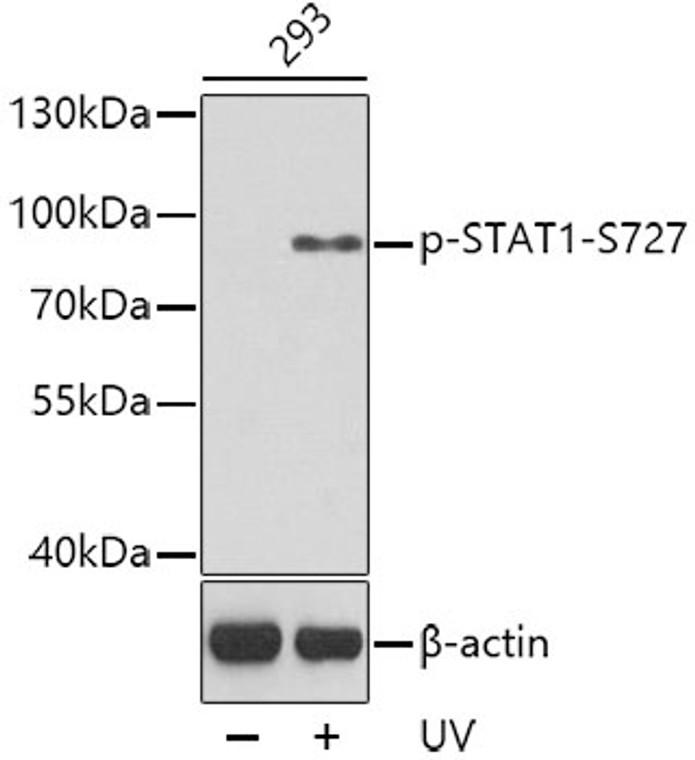| Host: |
Rabbit |
| Applications: |
WB/IHC/IF |
| Reactivity: |
Human/Mouse/Rat |
| Note: |
STRICTLY FOR FURTHER SCIENTIFIC RESEARCH USE ONLY (RUO). MUST NOT TO BE USED IN DIAGNOSTIC OR THERAPEUTIC APPLICATIONS. |
| Short Description: |
Rabbit polyclonal antibody anti-Phospho-STAT1-S727 is suitable for use in Western Blot, Immunohistochemistry and Immunofluorescence research applications. |
| Clonality: |
Polyclonal |
| Conjugation: |
Unconjugated |
| Isotype: |
IgG |
| Formulation: |
PBS with 0.01% Thimerosal, 50% Glycerol, pH7.3. |
| Purification: |
Affinity purification |
| Dilution Range: |
WB 1:500-1:2000IHC-P 1:50-1:100IF/ICC 1:100-1:200 |
| Storage Instruction: |
Store at-20°C for up to 1 year from the date of receipt, and avoid repeat freeze-thaw cycles. |
| Gene Symbol: |
STAT1 |
| Gene ID: |
6772 |
| Uniprot ID: |
STAT1_HUMAN |
| Immunogen: |
A synthetic phosphorylated peptide around S727 of human STAT1 (NP_009330.1). |
| Immunogen Sequence: |
PMSPE |
| Post Translational Modifications | Deubiquitinated by USP13.leading to STAT1 stabilization and positive regulation of type I and type II IFN signalings. Phosphorylated on tyrosine and serine residues in response to a variety of cytokines/growth hormones including IFN-alpha, IFN-gamma, PDGF and EGF. Activated KIT promotes phosphorylation on tyrosine residues and subsequent translocation to the nucleus. Upon EGF stimulation, phosphorylation on Tyr-701 (lacking in beta form) by JAK1, JAK2 or TYK2 promotes dimerization and subsequent translocation to the nucleus. Growth hormone (GH) activates STAT1 signaling only via JAK2. Tyrosine phosphorylated in response to constitutively activated FGFR1, FGFR2, FGFR3 and FGFR4. Phosphorylation on Ser-727 by several kinases including MAPK14, ERK1/2, CAMK2/CAMKII and CK2 in response to IFN-gamma stimulation, is required for maximal transcriptional activity. Phosphorylated on Ser-727 by CAMK2/CAMKII in response to IFN-gamma stimulation and calcium mobilization, promoting activity. Phosphorylated by CAMK2/CAMKII in response to IFN-beta stimulation and calcium mobilization in epithelial cells, promoting activity. Phosphorylation on Ser-727 promotes sumoylation though increasing interaction with PIAS. Phosphorylation on Ser-727 by PRKCD induces apoptosis in response to DNA-damaging agents. Phosphorylated on tyrosine residues when PTK2/FAK1 is activated.most likely this is catalyzed by a SRC family kinase. Dephosphorylation on tyrosine residues by PTPN2 negatively regulates interferon-mediated signaling. Upon viral infection or IFN induction, phosphorylation on Ser-708 occurs much later than phosphorylation on Tyr-701 and is required for the binding of ISGF3 on the ISREs of a subset of IFN-stimulated genes IKBKE-dependent. Phosphorylation at Tyr-701 and Ser-708 are mutually exclusive, phosphorylation at Ser-708 requires previous dephosphorylation of Tyr-701. Sumoylated with SUMO1, SUMO2 and SUMO3. Sumoylation is enhanced by IFN-gamma-induced phosphorylation on Ser-727, and by interaction with PIAS proteins. Enhances the transactivation activity. ISGylated. Mono-ADP-ribosylated at Glu-657 and Glu-705 by PARP14.ADP-ribosylation prevents phosphorylation at Tyr-701. However, the role of ADP-ribosylation in the prevention of phosphorylation has been called into question and the lack of phosphorylation may be due to sumoylation of Lys-703. Monomethylated at Lys-525 by SETD2.monomethylation is necessary for phosphorylation at Tyr-701, translocation into the nucleus and activation of the antiviral defense. (Microbial infection) Ubiquitinated by Herpes simplex virus 2 E3 ubiquitin ligase ICP22. |
| Function | Signal transducer and transcription activator that mediates cellular responses to interferons (IFNs), cytokine KITLG/SCF and other cytokines and other growth factors. Following type I IFN (IFN-alpha and IFN-beta) binding to cell surface receptors, signaling via protein kinases leads to activation of Jak kinases (TYK2 and JAK1) and to tyrosine phosphorylation of STAT1 and STAT2. The phosphorylated STATs dimerize and associate with ISGF3G/IRF-9 to form a complex termed ISGF3 transcription factor, that enters the nucleus. ISGF3 binds to the IFN stimulated response element (ISRE) to activate the transcription of IFN-stimulated genes (ISG), which drive the cell in an antiviral state. In response to type II IFN (IFN-gamma), STAT1 is tyrosine- and serine-phosphorylated. It then forms a homodimer termed IFN-gamma-activated factor (GAF), migrates into the nucleus and binds to the IFN gamma activated sequence (GAS) to drive the expression of the target genes, inducing a cellular antiviral state. Becomes activated in response to KITLG/SCF and KIT signaling. May mediate cellular responses to activated FGFR1, FGFR2, FGFR3 and FGFR4. Involved in food tolerance in small intestine: associates with the Gasdermin-D, p13 cleavage product (13 kDa GSDMD) and promotes transcription of CIITA, inducing type 1 regulatory T (Tr1) cells in upper small intestine. |
| Protein Name | Signal Transducer And Activator Of Transcription 1-Alpha/BetaTranscription Factor Isgf-3 Components P91/P84 |
| Database Links | Reactome: R-HSA-1059683 P42224-1Reactome: R-HSA-1169408Reactome: R-HSA-1433557 P42224-1Reactome: R-HSA-1839117Reactome: R-HSA-186763Reactome: R-HSA-2173795 P42224-1Reactome: R-HSA-6785807Reactome: R-HSA-877300 P42224-1Reactome: R-HSA-877312 P42224-1Reactome: R-HSA-8854691Reactome: R-HSA-8939902Reactome: R-HSA-8984722Reactome: R-HSA-8985947Reactome: R-HSA-9013508Reactome: R-HSA-9020956Reactome: R-HSA-9020958Reactome: R-HSA-909733Reactome: R-HSA-912694Reactome: R-HSA-9670439 P42224-1Reactome: R-HSA-9673767Reactome: R-HSA-9673770Reactome: R-HSA-9674555Reactome: R-HSA-9680350Reactome: R-HSA-9705462Reactome: R-HSA-9705671Reactome: R-HSA-982772 |
| Cellular Localisation | CytoplasmNucleusTranslocated Into The Nucleus Upon Tyrosine Phosphorylation And DimerizationIn Response To Ifn-Gamma And Signaling By Activated Fgfr1Fgfr2Fgfr3 Or Fgfr4Monomethylation At Lys-525 Is Required For Phosphorylation At Tyr-701 And Translocation Into The NucleusTranslocates Into The Nucleus In Response To Interferon-Beta Stimulation |
| Alternative Antibody Names | Anti-Signal Transducer And Activator Of Transcription 1-Alpha/Beta antibodyAnti-Transcription Factor Isgf-3 Components P91/P84 antibodyAnti-STAT1 antibody |
Information sourced from Uniprot.org
12 months for antibodies. 6 months for ELISA Kits. Please see website T&Cs for further guidance












